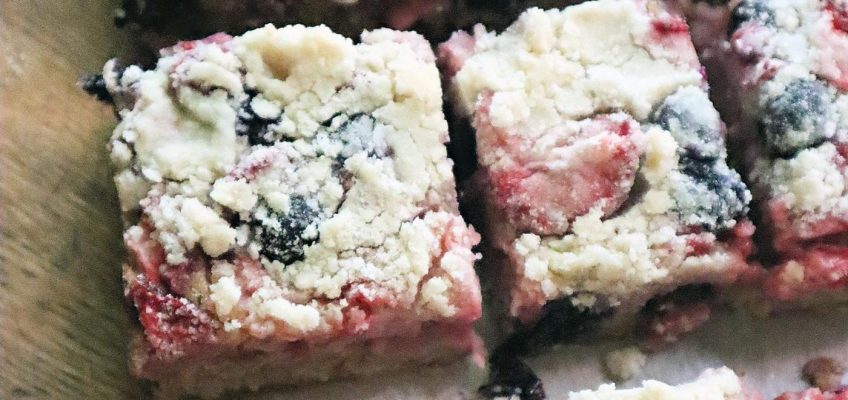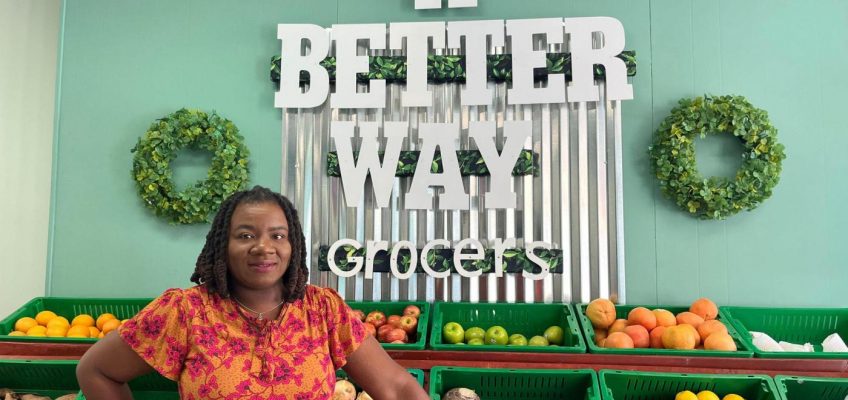By Gretchen McKay, Pittsburgh Post-Gazette
Summer heat often makes baking less than desirable, so if you’re going to heat up the kitchen to make dessert, you gotta make it worth every bead of sweat that collects on your forehead.
These berry crumb bars are worth it and then some.
Built on a forgiving shortbread-like crust (it’s supposed to be crumbly) and topped with gooey seasonal fruit, they offer all the great taste of a summer pie but are so much easier to make since you don’t have to bother with mixing and rolling out dough.
How easy is this recipe? While a food processor or KitchenAid mixer will certainly speed things along, all you really need to cut in the butter that helps create the crumbly bottom layer is a fork or pastry cutter and some good old-fashioned elbow grease.
I used a mix of blueberries and strawberries because the two fruits have such complementary flavors and are always easy to find, often on sale. Also, two contrasting colors are always more visually appealing in a dessert than one.
If you’re worried about the butter and sugar content, at least know this: Both fruits are fairly low-cal and packed with vitamin C and other nutrients. Also, blueberries are famous for their high antioxidant content.
Be sure to allow the bars to cool completely on a wire rack before slicing into squares or they will crumble. The original recipe finished the bars with a simple lemon glaze, but I served them without.
Lemon Strawberry Crumb Bars
These crumbly summer berry bars are filled with a mix of strawberries and blueberries. (Gretchen McKay/The Pittsburgh Post-Gazette/TNS)
Serves 16; PG tested
INGREDIENTS
3 cups all-purpose flour, spooned and leveled
1 teaspoon baking powder
1/2 teaspoon salt
1 cup unsalted butter, very cold and cubed
1 large egg
1 large egg yolk
1 cup packed light or dark brown sugar
2 teaspoons pure vanilla extract
2 cups chopped strawberries
2 cups blueberries
1/3 cup granulated sugar
1 1/2 tablespoons cornstarch
1 teaspoon lemon zest
For optional glaze
1 cup confectioners’ sugar, sifted
2 tablespoons fresh lemon juice (about 1 lemon)
Related Articles
Delicious, home-cooked meals can still be on the menu even in a wonky vacation rental
Recipe: When peaches are in season, make this delectable dessert
Spicy-sweet gochujang elevates this simple chicken stir-fry
A look at Starbucks and its Pumpkin Spice Latte, which returns to US menus Aug. 26
Gretchen’s table: Singapore shrimp burgers offer a sweet and spicy take on a summer classic
DIRECTIONS
Preheat oven to 350 degrees. Line the bottom and sides of a 9-by-13-inch baking pan with parchment paper, leaving an overhang on the sides to lift the finished bars out. (This makes cutting easier!) Set aside.
Make the crumble mixture for the crust and topping: Whisk flour, baking powder and salt together in a large bowl.
Add cubed butter and using a pastry cutter or two forks, cut in the butter until all the flour is coated and resembles pea-sized crumbles. (I whisked the ingredients together in a food processor.)
Whisk egg, egg yolk, brown sugar and vanilla together in a small bowl. Pour over the flour/butter mixture and gently mix together until the mixture resembles moist, crumbly sand.
Use your hands if needed — the mixture comes together easier with your hands than a spoon.
You will have about 6 cups of the crust/crumble mixture. Set 2 cups aside.
Pour the remaining crumble mixture into the prepared pan and flatten down with your hands or a flat spatula to form an even crust. It will be a little crumbly — that’s OK. Set aside.
Make filling: In large bowl, mix strawberries, blueberries, granulated sugar, cornstarch and lemon zest together. Spoon evenly over crust.
Crumble the remaining butter/flour mixture on top and gently press down so it’s snug on the strawberry layer.
Bake for 45-50 minutes or until the top is lightly browned and the strawberry filling is bubbling on the sides. (My bars took about 55 minutes.)
Remove from the oven and place the pan on a wire rack. Allow to cool completely.
If adding a glaze, whisk the glaze ingredients together and drizzle on top of the bars (or you can drizzle on individual squares).
Lift the cooled bars out using the overhang on the sides. Cut into squares.
Cover and store leftover bars (with or without icing) at room temperature for up to 2 days, in the refrigerator for up to 1 week and in freezer for up to 3 months (arrange in even layers between sheets of parchment). To serve frozen bars, thaw overnight in the refrigerator, then bring to room temperature before serving.
Adapted from sallysbakingaddiction.com
©2025 PG Publishing Co. Visit at post-gazette.com. Distributed by Tribune Content Agency, LLC.




